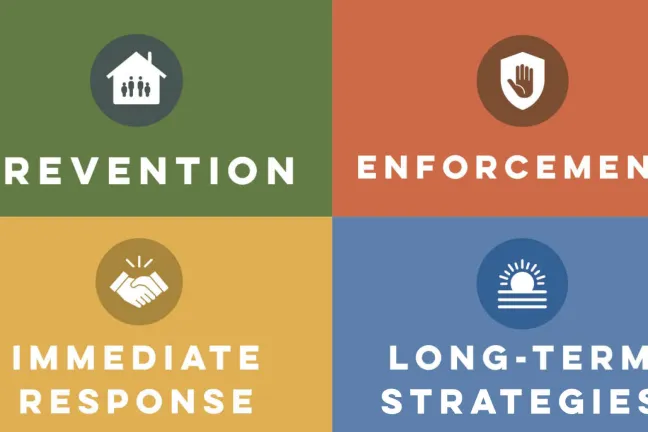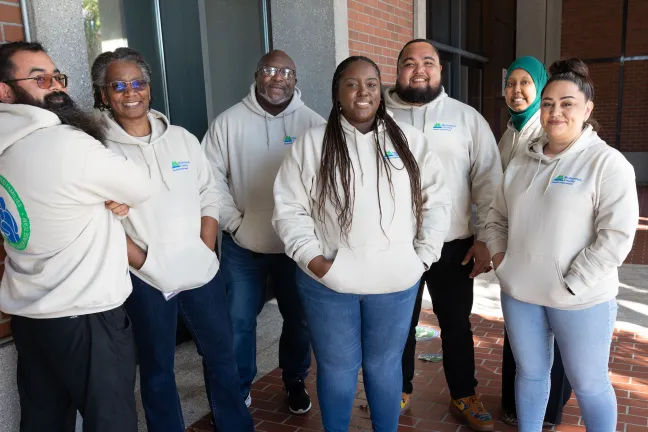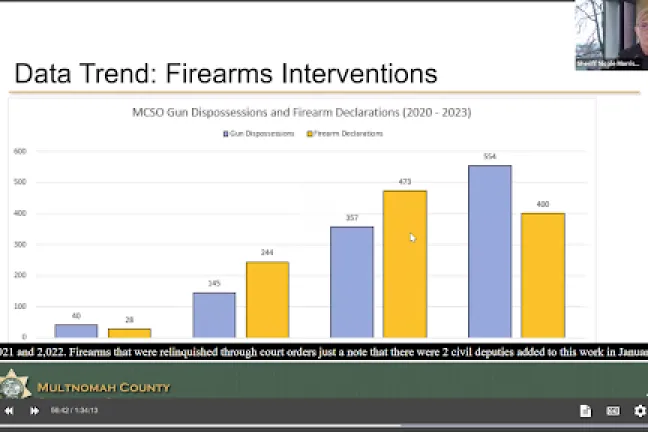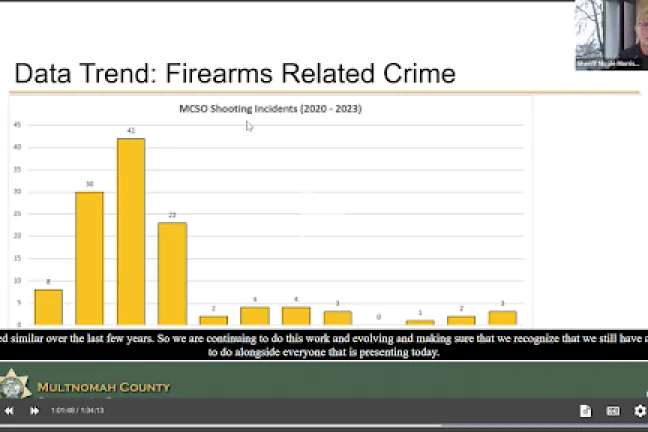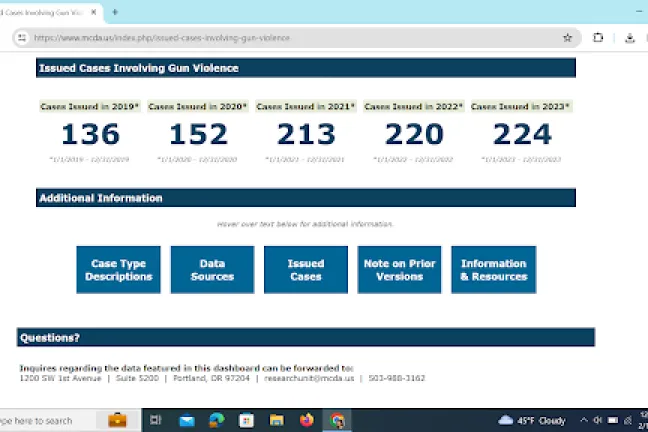Communities in Portland and Multnomah County have seen reduced incidents and rates of gun violence — one of the most pressing and consistent issues that emerged in the wake of the pandemic.
That progress, members of Multnomah County’s Local Public Safety Coordinating Council (LPSCC) heard at their January 22, 2024 meeting, is due, in part, to over three years of substantial, coordinated investments and unprecedented collaboration across jurisdictions.
While the news is encouraging, with a decrease in gun violence from 2022 to 2023, it is in no way a victory lap as many speakers stressed. Work still remains to address gun and community violence, particularly in communities that are still experiencing elevated levels of violence.
As federal dollars that supported many of these new violence prevention investments begin to sunset, Multnomah County Chair Jessica Vega Pederson cautioned that the local public safety system must examine how it can remain committed to effective programs. In the past, she said, investments in anti-violence programs were curtailed or removed once they started showing results.
“Then we get into the situation where the community supports and the really important work that led to that decrease is gone. And you find yourself in a situation where you need it, it's not there,” Chair Vega Pederson said. “We also know, looking at the data, that there are still racial disparities in victims of violence.”
Multnomah County and the cities of Portland and Gresham experienced consecutive record-breaking years of gun violence rates in 2021 and 2022 because of factors and conditions exacerbated by the pandemic, said LPSCC Strategic Initiatives Manager Raffaele Timarchi.
“In response, all three jurisdictions and the system at-large have put every available resource from state and federal American Rescue Plan dollars to General Fund supplemental budgets to reduce gun violence,” he said.
While the current downward trend is encouraging, it also shows that sustained efforts and investments are required to return to pre-pandemic levels, said Timarchi. “Many of the specialized efforts and initiatives we were able to stand up relied on federal and state recovery funds that sunset the summer of 2024.”
Gun violence prevention efforts are guided by three themes, Timarchi continued.
First, gun violence is preventable.
“It may seem obvious, but nonetheless it’s a very important presupposition," he said. “For every gun violence incident that occurs, there are many committed people working extremely hard before and after the event to mitigate the harm caused by gun violence and prevent violence from occurring in the future.”
Second, it’s imperative that strategies and approaches inclusively lead with race.
“We know that gun violence disproportionately impacts Black, Indigenous and other communities of color. In 2021 and 2022, more than half of the victims of gun violence were people of color, with Portland’s Black community representing about 40% of those killed by guns despite making up less than 6% of the City's population,” Timarchi said.
Inclusively leading with race recognizes that racial inequities are deep, pervasive and baked into our culture and systems and works to address the causes which are often rooted in poverty, disinvestments in schools and neighborhoods and more.
Third, responding to gun violence requires collaboration and coordination across the continuum of strategies and responses, even as the public safety system faces an overwhelming volume of incidents, strained resources and workforce shortages.
“There is no singular solution or program that will reduce gun violence on its own. This means that not only cities and counties are working together, but working inter-departmentally and with trusted community partners,” Timarchi said. “If there is any silver lining to this crisis, it’s that we’ve learned to work together better and that’s a principle we can’t lose.”
A steady stream of representatives from various departments, agencies and jurisdictions followed Timarchi, together illustrating the breadth of interventions and coordination that have contributed to the downturn, including: (Click on a link to skip down to the corresponding section.)
- Multnomah County Public Health Division
- Multnomah County Behavioral Health Division
- Department of Community Justice Community Supervision
- Multnomah County Sheriff’s Office
- Multnomah County District Attorney’s Office
- City of Portland
- City of Gresham
Multnomah County Health Department
Charlene McGee, the Prevention and Health Promotion Director for the County Health Department, described the ongoing efforts of the County’s Public Health Division.
The division’s, which focuses on the population level, includes:
- Implementing policies, systems and environmental change.
- Conducting communication campaigns.
- Enhancing connections and access to mental health services.
- Engaging in upstream work to decrease risk factors.
An often cited illustration of “upstream” work is imagining two people fishing on a riverbank who see someone coming down the river struggling to stay afloat. They immediately jump into action and bring the person ashore. Then they see another person, and another.
They travel upstream and see a cliff with a beautiful view that people are leaning over to observe and falling into the river.
The two observers’ efforts were reactive at first. But then they thought about what they could do to prevent people from falling into the river in the first place. They placed a sign explaining the risks, put up a fence and put in a bench to make it accessible and safe.
McGee highlighted the Community and Adolescent Health (CAH) team, which works on preventing violence upstream, rather than intervening, by addressing its root causes. To do this, the team collaborates with youth-driven organizations, such as Multnomah County’s Youth Advisory Board, Youth Commission and Student Health Action Council, among others.
The Public Health Division also supports culturally specific organizations by offering feedback and supplementing their violence prevention efforts through small grants. The Crime Prevention Through Environmental Design (CPTED) program engages community members who help design projects that improve the built environment, creating healthier spaces in which people can live, work, play and worship. CPTED projects include murals, festivals and other projects during the summer that foster social cohesion throughout neighborhoods.
In addition, the division offers curriculum and training designed to equip youth and adults with the skills to navigate the world confidently and safely, manage their emotions, and learn how to respond to different stressors they may encounter.
Multnomah County Behavioral Health Division
Yolanda Gonzalez, the senior manager of Direct Clinical Services within the County’s Behavioral Health Division, shared the latest insights into the critical work of the Gun Violence Impacted Families Behavioral Health Response Team (GVIFBHRT).
The team clinically addresses mental health symptoms of people and families impacted by gun violence through culturally responsive, evidence-based, person-centered and trauma-focused services. The program is designed to be low barrier and is committed to bringing a racial equity lens and partnering with community-based organizations.
That results, said Gonzalez, in empowerment and healing.
“We are a culturally specific program with an intention to focus on the African American African Immigrant and Refugee and Latino population,” said Gonzalez.
“We serve anyone between the ages of 10 to 25 who are referred to us. Everyone who is referred to us either works with us directly or we connect them to another provider in the community to make sure they’re connected to begin that healing journey.”
The team consists of six providers: three mental health clinicians and three credible messengers, all with the expertise and lived experience from the communities the County serves. As of January 2024, the program has provided 684 services including a variety of behavioral health approaches to address the trauma and impact of gun violence to 143 individuals and families.
Scott Williams, a Direct Clinical Services program manager, said there are four primary providers with which BHGVIFRT partners: The Immigrant and Refugee Community Organization (IRCO), IRCO Africa House, Portland Opportunities Industrialization Center (POIC) + Rosemary Anderson High School, and Latino Network.
“These organizations bring valuable lived experience and support to our program and the families we serve,” said Williams
The team has also conducted targeted outreach with African immigrant populations, hosting listening sessions and engaging leaders from the Somali American Council of Oregon, “letting them teach us how they can be served,” said Williams.
The team also provides immense support to Portland Public Schools, including Jefferson, Franklin and Cleveland high schools, through individual support for both staff and students, as well as psycho-educational groups.
Their work extends to partnerships through the K-12 Case Management Program, which provides case management services through Multnomah County to students experiencing truancy and their families.
The Behavioral Health Gun Violence Impacted Family Response Team also works “extremely closely” with Multnomah County’s Department of Community Justice (DCJ), which provides parole and probation services, said Williams. DCJ has accounted for 20% of referrals to BHGVIFRT, while Latino Network has provided 15%, POIC + Rosemary Anderson High School has provided 14% and Portland Public Schools has provided 14%.
Community Supervision
Travis Gamble, the Community Justice Manager for the Department of Community Justice Adult Services Division, emphasized the importance of community supervision in both adult and youth systems as “the nexus between social work, accountability and law enforcement.”
“We have a long history of doing violence prevention work," Gamble continued. “We know that gun violence occurs disproportionately in divested neighborhoods and communities that struggle with structural disadvantages such as poverty, racial segregation, lower access to education and high unemployment.”
Those communities, he said, are where their evidence-based, trauma-informed and culturally specific work is centered. Collaboration with community and system partners is “absolutely critical.”
Community Supervision staff use assessments that predict an individual’s risk of re-offense and identify barriers standing between them and services and resources. They approach case planning holistically, considering the whole human being; staff use motivational interviewing to build trust and rapport, said Gamble.
Recognizing that “there’s a lot of mistrust in our system,” the Community Supervision team is intentional about promoting transparency in their processes, said Gamble. “We attempt to encourage and empower our clients and change their behavior for the better.”
Bilingual staff work with youth and adults to ensure culturally competent and effective communication. Community Supervision also maintains strong relationships with community-based organizations and partnerships with law enforcement agencies and other system partners.
In addition, the Adult and Juvenile service divisions also include specialized units like the RISE Unit, which supervises gang-involved and impacted youth, the Gang Unit, the Domestic Violence Unit, the African American Unit and Women and Family Services.
DCJ has strong partnerships with community partners like POIC and Latino Network through the Community Healing Initiative Elevate program, which provides wraparound services for young adults and families in a way that acknowledges struggles, but also focuses on resilience of families and cultures, said Gamble. Through the Elevate program, families can receive mentoring, workshops for mental health and substance use disorders, employment training, parent mentorship, financial literacy classes and group counseling.
The Habilitation, Empowerment, Accountability, Therapy, or H.E.A.T. curriculum is a nine-month program designed for Black and African American men and women involved in and/or leaving the criminal legal system. The scope of H.E.A.T. has expanded over the last decade and there’s now a group in the juvenile detention facility.
“We just had a graduation for participants in the gang unit and we were able to get a group of individuals from rival gangs that are involved in the violence in the community right now to participate in this curriculum for nine months, in person, with each other,” said Gamble.
“We’re very proud of the work that they did to stay focused. We’re also proud that none of them hurt each other.”
Gamble also shared about the DCJ’s involvement in Operation Ceasefire alongside the Portland Police Bureau, the City of Portland’s Office of Violence Prevention, the District Attorney’s Office, the County Health Department, Oregon Youth Authority and others.
“We attend shooting reviews and develop custom notifications to engage individuals who have been involved in gun violence.. to reduce the likelihood of retaliation," said Gamble.
While much of the downturn in gun violence is due to the system collaboration, “I don’t think this is a time for us to celebrate,” Gamble cautioned. “There’s a lot of work to be done to get numbers down to pre-pandemic levels. I think it’s important that we continue to stay focused on the communities we serve.
“Even when politics, policies, dollars ebb and flow, I’m just hoping we can remain committed to investing in long-term strategies to prevent the extreme levels of violence that the community has been suffering for the last several years.”
Multnomah County Sheriff’s Office
Multnomah County Sheriff Nicole Morrisey O’Donnell described the strategic investments made in gun dispossession through civil processes, and focused data-driven missions and investigations, as well as relationships with community partners — all designed to reduce gun violence.
The Gun Dispossession Unit focuses on removing firearms from individuals who have a protection order in place against them and a court order requiring them to surrender their guns within a specific time frame.
“The team, along with deputies assigned to the Civil Unit, serve protection orders to immediately remove firearms. They build relationships with petitioners and assist in safety and holding respondents accountable by court orders,” said Morrisey O’Donnell.
Because the number of dispossession and firearm declarations has significantly increased since 2020, the Sheriff’s Office added two civil deputies in 2022 to assist the work. Gun dispossessions specifically have increased from 40 in 2020 to 544 in 2023.
“By removing a firearm, we may be able to reduce the lethality of these extremely volatile situations and keep guns out of the hands of those who pose the most risk,” said the Sheriff.
The Enforcement Team ensures that cases are seen through to prosecution, providing accountability and closure for impacted families and community members.
The Sheriff’s Office is also part of the Major Crimes Team, “a collaborative, investigative team that’s called upon when a death or serious injury occurs,” said the Sheriff. The team also includes the Multnomah County District Attorney’s Office, Gresham Police, the Port of Portland and Oregon State Police.
Throughout these investigations, detectives ensure that evidence is collected and tested. A shell casing submitted by detectives for analysis, for example, could help determine if a particular firearm was used in other shootings, said Morrisey O’Donnell.
The Sheriff’s Office regularly meets with multiple partner agencies to share situational awareness and information on trends. For example, the office meets with the County Department of Community Justice and the City’s Office of Violence Prevention to collaborate on intervention strategies and perform community outreach.
“Our investigators are fully engaged in ensuring that we assist in community partnerships, enforcement, prevention and the intervention, but also very invested in ensuring we’re communicating with all of our partners to reduce gun violence,” said Morrisey O’Donnell.
Meanwhile, the Special Investigations Unit, which focuses on criminal organizations, “has been responsible for many large scale seizures of drugs and firearms over the last few years,” she said.
The Sheriff’s Office also launched “Enhanced Public Safety Initiatives,” which are focused, data-based missions to which the office commits additional resources to contribute to additional law enforcement presence or interventions.
“We’ve tailored these initiatives for stolen vehicle missions, traffic enforcement to combat dangerous driving, as we’ve recognized there's a correlation to gun violence incidents and stolen vehicles," said the Sheriff. Her office has also worked with transit police to address retail theft and human trafficking, as well as “increased drug use and violence in the City of Portland where there’s a nexus to transit.”
Community engagement efforts play a vital role in violence prevention efforts, too. The Sheriff’s Office connects with business owners and residents who welcome the presence of law enforcement officers and signals of accountability in areas of high concern. The Sheriff’s Office is committed to meeting people in the community and connecting with community groups to listen to their concerns and answer questions.
“It’s about creating a bridge of understanding where community members feel comfortable enough to approach law enforcement, and we continue to work toward building trust in our neighborhoods,” she said.
Confirmed shooting incidents have decreased by approximately 40% from 2020 to 2023, said Morrisey O’Donnell. But a great deal of work remains because shootings resulting in injuries and homicides have remained at a similar level, added the Sheriff.
We have a command member who attends council meetings for the Sheriff’s Office contract cities including Maywood Park, Fairview, Troutdale and Wood Village and answers questions.
And a detective has been assigned to represent the Sheriff’s Office and participate in the new Oregon Health & Science University Gun Violence Review Commission, a newly created group that will use a public health approach to examine cases of gun violence in Multnomah County, identify specific circumstances that lead to gunfire, and ultimately make recommendations to reduce firearm deaths and injuries in the community.
Multnomah County District Attorney’s Office
Shawn Overstreet, a senior deputy district attorney with the Multnomah County District Attorney's Office, highlighted the importance of both holding individuals responsible for gun violence accountable and assisting victims as they navigate the criminal justice system.
Between 2019 to 2022, the office issued nearly 100 additional cases involving gun violence. The unit responsible for issuing these cases consists of 11 deputy district attorneys, including two senior district attorneys.
“These numbers… only represent the cases issued by our office. They don’t account for the total amount of gun violence or cases that aren’t referred to our office because there is no suspect, cases that we reject because of the need for follow-up, or (cases) that have proof problems that we can’t proceed,” explained Overstreet.
“This is a very water-downed amount of cases that get issued every year and it’s still a high number.”
The most significant increase in gun violence came in 2020, a byproduct of the City’s decision to disband its Gun Violence Reduction Team, said Overstreet. The numbers have leveled off since with the establishment of the Enhanced Community Safety Team (ECST) and the Focused Intervention Team (FIT).
“Our office is holding people accountable,” said Overstreet. “We have embedded a district attorney into the ECST to help facilitate warrants, subpoenas and focused interventions with offenders.”
The workload has increased to the point where the office added an additional district attorney. Attorneys attend roll calls with the City of Gresham, the Federal Bureau of Investigations and the Bureau of Alcohol, Tobacco, Firearms and Explosives, and the County’s Department of Community Justice. They also attend shooting reviews and coordination meetings with Portland's Office of Violence Prevention and Operation Ceasefire.
Racial disparity among victims is still high however, Overstreet said.
“What we’re finding is that the underserved communities are not wanting or trusting the criminal justice system and groups not wanting to participate in prosecution,” Overstreet said.
City of Portland
Elisabeth Perez, deputy director for the City of Portland’s Community Safety Division, described its prevention, intervention and enforcement efforts.
Sharing a timeline from January 2019 through November 2023, Perez noted that while Portland saw a relatively low number of gun-related incidents before 2019, it saw the largest increase in such incidents — 200% — within this period.
“The numbers represent people who have lost their lives,” Perez said about the gun violence statistics. “These are individuals who have experienced trauma and mental change in their everyday life, so I want to be sure that we’re focusing on the people who are impacted by our work.”
Though we can’t point to any single causes for this increase in gun violence, recognizing that the pandemic, civic unrest, and an increase in fentanyl use all occurred in this time frame provides necessary context.
In response, Mayor Wheeler declared a gun violence emergency declaration in July 2022, which “resulted in increased coordination between city bureaus and external partners (as well as) an increase in funding with a goal of reducing gun violence by 10% over the next two years.”
What Portland actually saw from 2022 to 2023 was a 21% decrease in gun homicides and a 22% decrease in total shooting incidents.
“We’ve seen some positive trends and we surpassed the original goal, which is good news,” Perez said. “So we are moving in the right direction.”
Sierra Ellis, Operation Ceasefire program director, described the successful impact of the approach — a focused deterrent strategy used in dozens of cities, nationally.
“By combining resources and expertise, we’ve created a comprehensive strategy tailored directly to Portland. We’re ensuring those at highest risk of becoming victims or perpetrators of gun violence, understand the implications of their behavior,” said Ellis. Ceasefire’s work is driven by data and best practices — a compassionate yet focused approach that has “the preservation of life as its Number One goal,” she said.
The initial step involved a comprehensive gun violence problem analysis which establishes a common understanding and guides the work of civic, community and criminal justice leaders to reduce violence.
Among several regular meetings, Ellis highlighted the weekly shooting review as the engine that drives the strategy forward involving law enforcement, PPB, the FBI, Multnomah County probation and parole, and others. This convening starts with a review of the shooting incidents over the previous seven days, providing insight into group conflicts and areas considered hot spots.
“Then there is a coordination meeting which focuses on gaining a deeper understanding of individuals driving gun violence, particularly those who meet risk factors,” Ellis explained. “From here we devise a strategy either through custom notification or referral process to the Office of Violence Prevention.”
A custom notification is a direct, respectful message to an individual in gun violence informing them of their risk level and helping them understand the consequences of their actions. Recipients are referred to an intensive case management system with partners such as Going Home II, Nurture Outreach Services and POIC + Rosemary Anderson High School.
Office of Violence Prevention Director Marcelle Frazier said the office manages dozens of contracts from street-level outreach to intensive case management.
Street-level outreach workers are deployed to locations that data show are hotspots for gun violence. They provide on-site conflict resolution and engage with community members, then make referrals and connect them to services. Outreach workers identify the people they should be working with through the help of Ceasefire, Portland Police Bureau, the Focused Intervention Team and the National institute of Criminal Justice Reform.
“We work to decrease recidivism, find stable housing and reduce violence and more,” Frazier said. “Intensive case managers provide ongoing life coaching to those at highest risk of being a victim or perpetrator of gun violence.” Life coaching, he clarified, includes job placement, housing relocation, educational placement, conflict mediation, and mental health services that can reduce the likelihood someone perpetrates or becomes revictimized by gun violence.
The OVP includes the Safe Blocks Program, which deploys community engagement — outreach, listening sessions and even CPTED projects — to violence hotspots identified by data. The ultimate goal is to activate community spaces, decrease incidents of violence, and in the process improve perceptions of public safety. The program also hosts tabling events and training sessions.
Portland Police Acting Lieutenant Chuck Greulich talked about the Enhanced Community Safety Team, which is actually composed of two teams: a gun violence investigations team, which investigates all injury shootings, and the Ceasefire Team, which pairs each of four PPB detectives with one or two officers. Together, ECST generates street-level intelligence, social network analysis, ballistics tracking, and shooting review to paint a picture of the current dynamics and act on it,” Greulich said.
“We lean towards targeted enforcement, as you know a smaller segment of the population is responsible for a disproportionate amount of shootings and follow through, charging and prosecution. We work closely with our two district attorneys as sometimes our cases need follow up and touch.”
Sometimes, the unit finds that those who are involved in gun violence are involved in other kinds of cases. For instance, Greulich shared, ECST found someone identified through a shooting review was likely to be a victim or perpetrator in a domestic violence case.
Greulich went on to talk about the Focused intervention Team, which patrols in the evenings in uniform. And they receive guidance from the FIT-Community Oversight Group. They were created in January 2022. They can write affidavits for search warrants, organize tactical assistance through SERT teams. FIT’s metric for success is a year-over-year reduction in gun-related homicides and injury shootings.
“They’re the eyes and ears of the Ceasefire strategy,” Greulich said. “They're out there making contacts. They complete and assist in action items. The team also engages with the community through outreach.”
“The strategy is working because we’re working together (and) we anticipate stronger coordination,” said Perez, who ended the presentation.
“Our 22% decrease in gun violence is not just a statistic, but indicates people who are alive today because of the work that we’ve collectively done. It’s a good start, but we have a long road ahead.”
City of Gresham
Joe Walsh, the Neighborhood Livability and Community Services director for the City of Gresham, shared about the work being done in East Multnomah County.
Walsh shared that he was hired by the city in 2014, a year after a spike in shootings resulted in seven homicides, six of which were related to gang activity. His task was to “help figure out what we could do as a city with a limited budget to create a more comprehensive approach to addressing gun violence,” said Walsh.
“For several years in Gresham we knew we wanted to do more, but struggled to find the resources to implement that plan.”
Then in 2020, the City learned that its East Metro Gang Enforcement Team was unlikely to get funding for the next biennium.
“So we pivoted and tried to make lemonade out of lemons,” he said.
The city began advocating to the Legislature for the reinvestment of those funds into prevention, intervention and upstream services. With an initial $2 million investment, the City of Gresham launched East Metro Outreach and Intervention, which collaborates with various partners — including POIC + Rosemary Anderson, New Avenues for Youth and Portland Public Schools to help youth and families in the community. The Youth Services Team, which supports youth and young adults with safe, fun recreation and social activities is one of the newest efforts.
City of Gresham staff serve as the backbone of the organization, ensuring that everyone is “pulling the rope from the same direction and that we’re directing funding and measuring outcomes,” said Walsh.
As a result, the city has seen “a decrease in shootings and injuries by about a third from 2022 to 2023.”
Watch the full meeting here.
####
